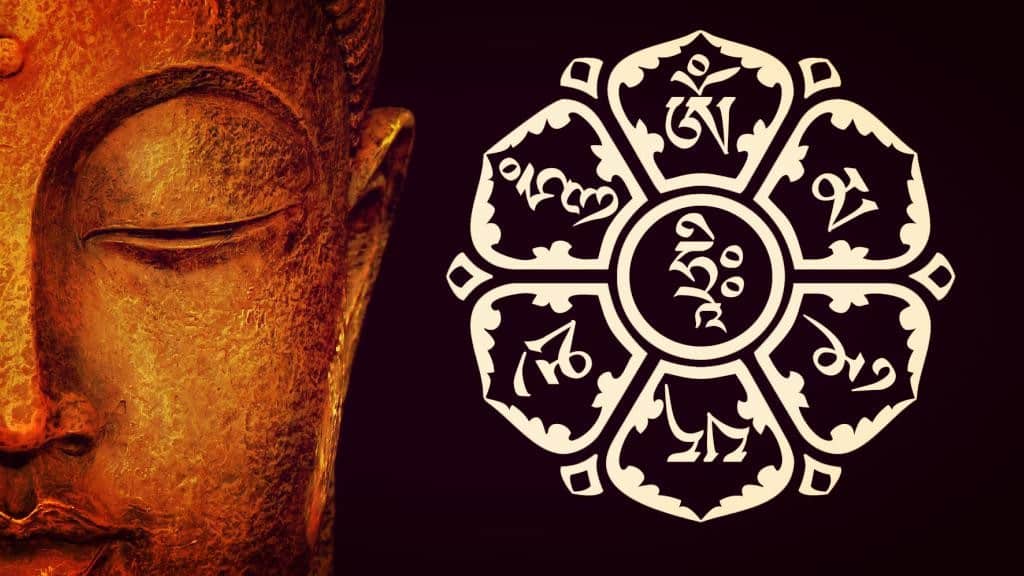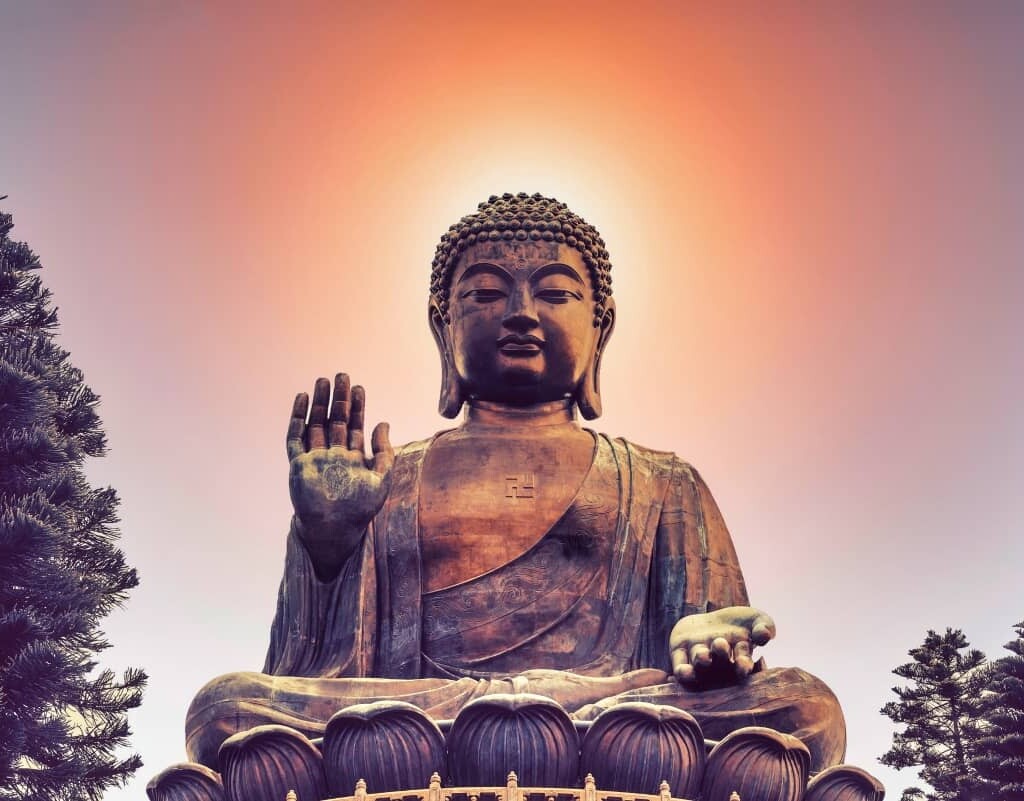Ever wondered about the true power behind the mantra Om Mani Padme Hum? Discover the fascinating story of Avalokiteshvara, the bodhisattva committed to ending all suffering. Explore how compassion in Buddhism can lead to personal and spiritual transformation. This insightful guide will illuminate your understanding and inspire your practice. Click now to uncover the wisdom of Avalokiteshvara and his sacred mantra!
The Profound Meaning of the Om Mani Padme Hum Mantra
Each of the six syllables of this mantra has a profound spiritual and symbolic meaning intended to purify the spirit and aid in the path to enlightenment.
“Om” is the primordial sound, representing the purity of body, speech and mind. “Mani” means “jewel,” symbolizing the altruistic intention to become enlightened, compassion and love. “Padme” translates to “lotus,” a symbol of wisdom. Finally, “Hum” denotes indivisibility, the union of wisdom and compassion.
Repeating this mantra is a common practice that helps practitioners cultivate compassion and connect with all sentient beings, bringing them closer to enlightenment.
The mantra “Om Mani Padme Hum” consists of six syllables, each with deep meaning and symbolism. His Holiness the Dalai Lama has emphasized the importance of reciting the mantra with an understanding of its meaning, as each syllable encapsulates fundamental Buddhist teachings.
- Om: Represents the pure body, speech and mind of a Buddha.
- Mani: Means “jewel” and symbolizes the altruistic intention to achieve enlightenment, compassion and love.
- Padme: Means “lotus” and symbolizes the wisdom that arises from purity.
- Hum: Represents the indivisibility of method and wisdom.
The symbolism of the Syllables in Om Mani Padme Hum
Each syllable of the mantra “Om Mani Padme Hum” is loaded with symbolism and is associated with different aspects of the Buddhist path to enlightenment.
OM
- Meaning: Symbolizes the body, speech and mind of the Buddhas.
- Symbolism: Purifies the veil of the body and closes the door to rebirth in the realm of the devas.
- Associated Virtue: Generosity.
- Associated Wisdom: Wisdom of equanimity.
- Associated Buddha: Ratnasambhava.
MA
- Meaning: Represents the speech of the Buddhas.
- Symbolism: Purifies the veil of speech and closes the door to rebirth in the realm of the asuras.
- Associated Virtue: Ethics.
- Associated Wisdom: Wisdom of activity.
- Associated Buddha: Amoghasiddhi.
NI
- Meaning: Represents the mind of the Buddhas.
- Symbolism: Purifies the veil of the mind and closes the door to rebirth in the human realm.
- Associated Virtue: Patience.
- Associated Wisdom: Wisdom that arises by itself.
- Associated Buddha: Vajradhara.
PAD
- Meaning: Symbolizes the virtues of the Buddhas.
- Symbolism: Purifies the veil of conflicting emotions and closes the door to rebirth in the animal realm.
- Associated Virtue: Diligence.
- Associated Wisdom: Wisdom of the Dharma.
- Associated Buddha: Vairocana.
ME
- Meaning: Represents the acts of the Buddhas.
- Symbolism: Purifies the veil of latent conditioning and closes the door to rebirth in the realm of hungry spirits.
- Associated Virtue: Concentration.
- Associated Wisdom: Wisdom of discrimination.
- Associated Buddha: Amitabha.
HUM
- Meaning: Represents the sum of the grace of the body, speech, mind, virtue and activity of the Buddhas.
- Symbolism: Purifies the veil that covers knowledge and closes the door to rebirth in hell.
- Associated Virtue: Wisdom.
- Associated Wisdom: Wisdom like a mirror.
- Associated Buddha: Akshobhya.
The Story of Avalokiteshvara in Buddhism
Avalokiteshvara is a central figure in Mahayana Buddhism, known for his infinite compassion and his commitment to liberate all beings from the suffering of samsara. According to legend, Avalokiteshvara made a monumental vow: not to achieve complete enlightenment until all other beings had done so.
This bodhisattva descended to the hell realms and ascended through the various planes of existence, helping countless beings. However, realizing that other beings continued to fall into suffering in equally immense numbers, he sank into deep sorrow until his body shattered into a thousand pieces.
Desperate, Avalokiteshvara asked all the Buddhas for help, who reconstituted him with eleven heads and a thousand arms, each with an eye in the palm, symbolizing the union of wisdom and compassion. In this new form, Avalokiteshvara became even more powerful and committed to his mission of helping all beings.
Compassion in Mahayana Buddhism
Compassion is one of the fundamental pillars of Mahayana Buddhism. Avalokiteshvara is the personification of this quality and his story and teachings inspire practitioners to follow his example. Compassion in this context is not simply a feeling of sympathy, but a deep active commitment to alleviating the suffering of all sentient beings.
In Mahayana Buddhism, it is taught that all beings have the capacity to achieve Buddhahood, and the practice of compassion is essential on this path. Reciting the mantra “Om Mani Padme Hum” is a powerful tool to cultivate this compassion, as each repetition of the mantra purifies the spirit and brings the practitioner closer to enlightenment.
Mahayana sutras narrate that Avalokiteshvara received the mantra directly from the Buddha, who entrusted him with the task of helping all beings achieve enlightenment. This symbolic act underscores the importance of compassion and the interconnectedness of all beings on the Buddhist path.
The Transformation of Avalokiteshvara and the Taras
In a moment of great desolation, Avalokiteshvara’s tears transformed, by the blessing of the Buddhas, into two manifestations of compassion: Green Tara and White Tara. Green Tara represents the active force of compassion, while White Tara embodies the maternal and protective aspect.
The name “Tara” means “The One Who Liberates,” symbolizing these deities’ ability to guide beings across the ocean of samsara to the other shore of enlightenment. These figures are revered for their power and mercy and their worship is an integral part of Buddhist practice in many cultures.
The Practice of the Om Mani Padme Hum Mantra
Reciting the mantra “Om Mani Padme Hum” is a central spiritual practice in Tibetan Buddhism. This mantra is not only recited during meditation but is also inscribed on prayer wheels, prayer flags and steles. Each repetition of the mantra is seen as a way to purify the mind and spirit, bringing the practitioner closer to enlightenment.
Practitioners often recite the mantra repetitively, using a mala (Buddhist rosary) of 108 beads to keep track of the recitations. This repetition helps to center the mind and maintain focus on compassion and wisdom, qualities personified by Avalokiteshvara.
Additionally, visualization plays an important role in the practice of the mantra. Practitioners visualize the light and blessing of Avalokiteshvara penetrating their hearts, filling them with compassion and dispelling suffering and negativity. This practice benefits not only the individual but is also believed to have a positive impact on all beings.
Spiritual and Psychological Benefits of the Mantra
Repeating the mantra “Om Mani Padme Hum” offers numerous spiritual and psychological benefits. From a spiritual perspective, the mantra helps to purify negative karma and cultivate virtue. The constant recitation of the mantra also facilitates a connection with Avalokiteshvara and, consequently, with infinite compassion.
Psychologically, the practice of the mantra can have calming and healing effects. The rhythmic repetition and focus on the sacred syllables can induce a state of deep meditation, reducing stress and anxiety.
Moreover, the focus on compassion and the well-being of all beings can foster a sense of purpose and connection, enhancing emotional well-being.
The mantra is also a powerful tool for developing resilience. When facing difficulties, practitioners can turn to the mantra as a source of strength and comfort, remembering Avalokiteshvara’s commitment to alleviating suffering and their own potential to achieve enlightenment.
Benefits of the Om Mani Padme Hum Mantra
Reciting the mantra “Om Mani Padme Hum” offers numerous benefits both spiritually and emotionally/mentally. Some of the most notable benefits include:
- Purification: Each syllable of the mantra helps to purify different aspects of being, from the body to emotions and knowledge.
- Protection: The mantra acts as a protective shield, closing the doors to rebirth in the realms of cyclic existence.
- Development of virtues: Reciting the mantra fosters the development of the six Paramitas or Transcendent Perfections: generosity, ethics, patience, diligence, concentration and wisdom.
- Personal transformation: It facilitates the transformation of the practitioner’s impure qualities into the pure qualities of a Buddha.
The Transformative Essence of the Om Mani Padme Hum Mantra
The mantra “Om Mani Padme Hum” is much more than a simple phrase; it is a profound and meaningful practice in Mahayana Buddhism. It encapsulates the essence of compassion and wisdom and offers a path to purification and enlightenment. Avalokiteshvara, the bodhisattva of compassion, inspires us with his unwavering vow and dedication to liberate all beings from suffering.
By incorporating the recitation of this mantra into daily life, practitioners can experience significant transformations in their minds and spirits, drawing closer to the Buddhist ideal of universal compassion.
The history and practice of the mantra “Om Mani Padme Hum” continue to be a source of inspiration and guidance for millions of people around the world, reminding us of the importance of compassion on our spiritual path.




